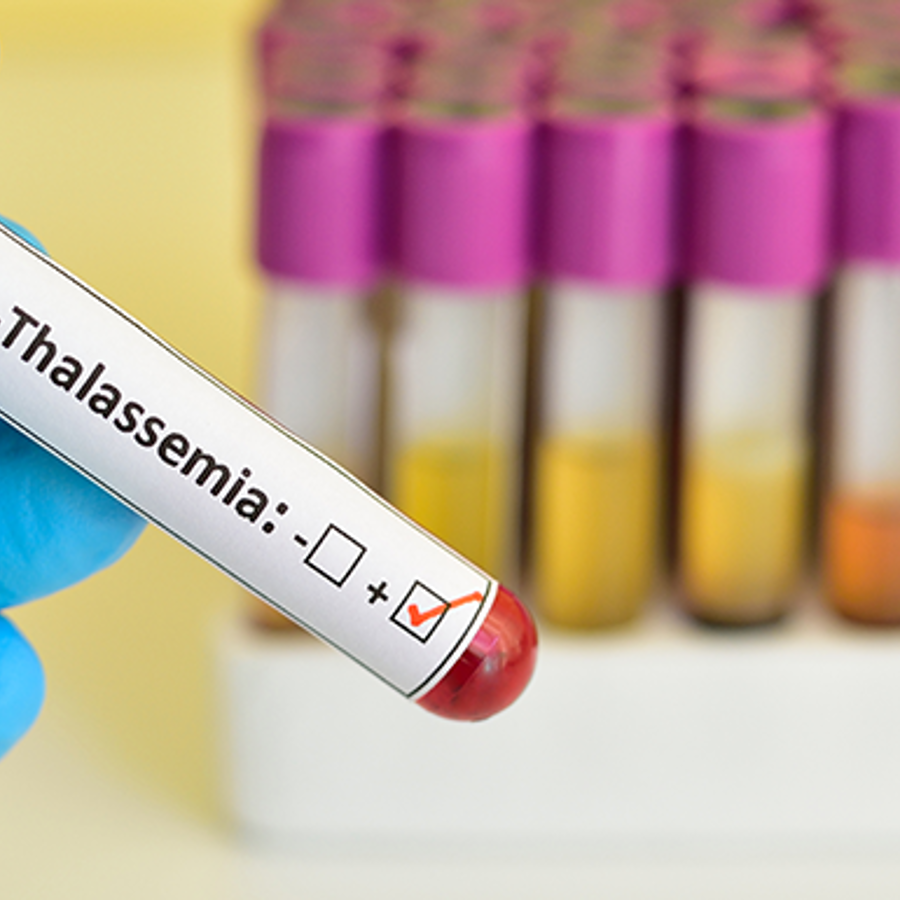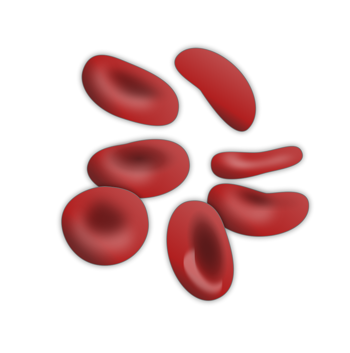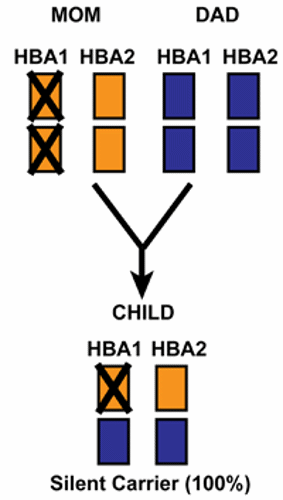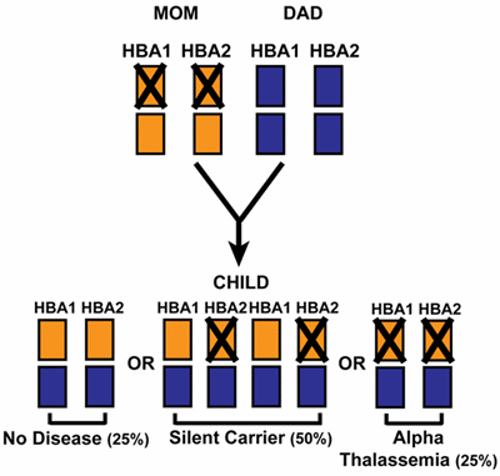
If I have alpha thalassemia would my kids be a carrier for my genes?
April 27, 2011

- Related Topics:
- Complex traits,
- Genetic conditions
A curious adult from Missouri asks:
"If I have alpha thalassemia would my kids be a carrier for my genes?"
Great question! And not an easy one to answer. Alpha thalassemia is complicated because two different genes are involved.
It is also complicated by the fact that there are different severities of the disease and each has its own genetic make up. This means the possibilities of a child having the disease change for each genetic-makeup.
As I go over each possibility, keep in mind that I am assuming that your partner is neither a carrier nor has the disease. All these odds change if either is the case.
The most severe form that can go on to children is called HbH, or HbH disease. People with HbH have a lot of complications, but live on well into adulthood.
If you have HbH and your partner is not a carrier and does not have the disease, then odds are that none of your kids will end up with HbH. Each child would have a 50% chance at being a silent carrier and a 50% chance of having a milder form of the disease called alpha thalassemia trait.
If you have alpha thalassemia trait, then things are a bit fuzzier. People with this form of alpha thalassemia can have one of two different genetic make-ups. The chances of your kids being carriers or even ending up with the disease depend on which one you are.
With one genetic make-up, all of your kids will be silent carriers but none will have the disease. In the second genetic make-up, each child has a 50% of being a silent carrier, a 25% chance of not being a carrier at all, and a 25% chance of having the alpha thalassemia trait too.

For the rest of the answer, I want to focus on what the difference is between these two genetic forms of alpha thalassemia and how I came up with these possibilities. And to do that, we need to take a step back and talk about genes, chromosomes and inheritance.
Genes and Inheritance: What's the deal?
Humans have 23 pairs of chromosomes that act like mini storage units for our genes. Each gene has the instructions for one small part of you like your hair, skin, and eye color, your blood type, genetic disorders and more! Taken all together, your genes are like an instruction manual for you.
You may remember that I said we each have 23 pairs of chromosomes. What this also means is that most of our genes come in pairs too.

We have two copies of each chromosome and so two copies of each gene. Via Wikimedia Commons
It is important to remember that there is no “alpha thalassemia gene” that causes the disease. We all have the alpha globin genes that are linked to the disease. Some people just have damaged versions of these genes and this is what causes the disease.
What makes alpha thalassemia so complicated is that there are two alpha globin genes, HBA1 and HBA2. This means that everyone has four copies of alpha globin genes.
Each copy of a gene is called an allele and a person gets one allele from their father and one allele from their mother. Because there are two genes involved, four alleles work together to make alpha globin protein.
Like I said before, there are many genetic possibilities with this disease, that can range in severity. Let's go through the different forms of the disease.
People affected by all forms of alpha thalassemia have problems making a protein called hemoglobin. Hemoglobin is a protein in red blood cells that carries oxygen to all cells in the whole body. So, as you can see, it is very important!
If a person is missing 2 out of the 4 alpha globin genes, they show mild symptoms of alpha thalassemia. These can include anemia (low amount of red blood cells), weakness, tiredness, and pale skin.
A person missing 3 out of the 4 alpha globin genes has a moderate version of the disease called HbH. Symptoms include what was described above as well as yellowing of the skin and eyes, bone overgrowth, and enlarged spleen and liver.
The most severe form of the disease is called Hb Bart Syndrome. In this case a person is missing all 4 of the alpha globin genes. The symptoms are so severe that most babies born with this disease die soon after birth.
Now that we know all the forms of alpha thalassemia, the next question is what are the chances of a parent passing on these genetic disease traits to their children? Let's take a look!
Genetic Inheritance and Roll of the Dice
I am going to assume you have alpha thalassemia trait and not HbH. This means you have one of two possible genetic profiles. Each affects your child's chances differently.
This is all pretty complicated so I have included a couple of pictures that might, hopefully, simplify things. In one case, you could have two alleles of HBA1 or two alleles of HBA2 that don't work right.
I have shown an example below of a case where someone has both their copies of HBA1 not working. This is represented with an X going through the box.
In this picture, genes from mom are in yellow and genes from dad are in blue. As you can see, dad will always give a working copy of HBA1 and HBA2...that is all he can give. Mom will also always give a working copy of HBA2. But she can only give a damaged version of HBA1 since both copies are damaged.

What this means is that all the kids will have one damaged copy of HBA1. They will all be silent carriers and not show any symptoms of the disease.
It gets more complicated in the second case. Here, mom has a damaged HBA1 and a damaged HBA2 gene. She also has a working copy of each.
In this case, there are four different genetic possibilities which I've outlined in the image below. As you can see, each child has a:
- 25% chance for getting all working HBA1 and HBA2 genes and not having the disease or being a carrier
- 50% chance for getting one damaged copy and being a silent carrier
- 25% chance of having two damaged copies and having alpha thalassemia too

It is important to remember that doctors can usually tell HbH from alpha thalassemia trait. But they can't tell what your genetic make-up is if you have alpha thalassemia trait without a genetic test.
Genetic testing involves looking at a person's genes and the presence or absence of proteins linked to those genes. A genetic test can tell which alpha thalassemia genetic profile you have and help you figure out your children's risks. Such tests are available and if you're interested, you should discuss it with a genetic counselor.
Genetic counselors are available through your local health provider and talking with a genetic counselor can also give you the most up-to-date information on the disease. For more information on what a prenatal genetic counselor does, click here, and for more information on where to find one, click here.

Author: Dr. Khameeka Kitt
When this answer was published in 2011, Khameeka was a postdoctoral fellow in the Department of Biology, studying initiation and stabilization of epithelial cellular adhesions in James Nelson’s laboratory. Khameeka wrote this answer while participating in the Stanford at The Tech program.
 Skip Navigation
Skip Navigation
